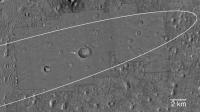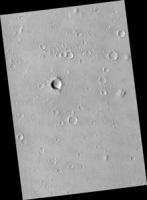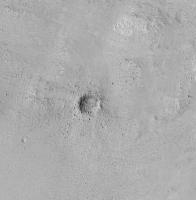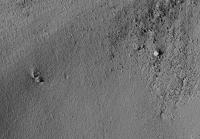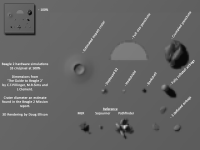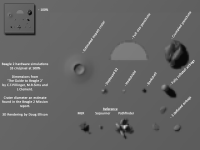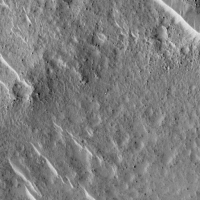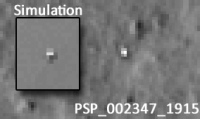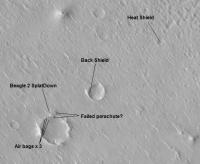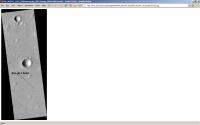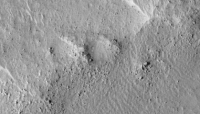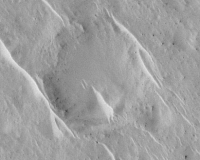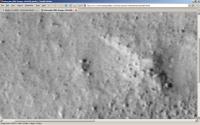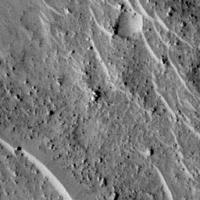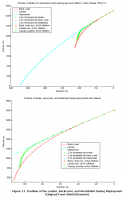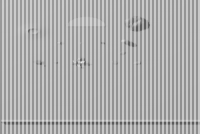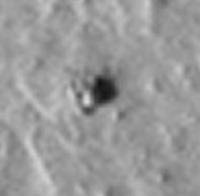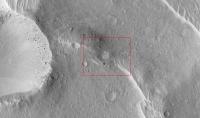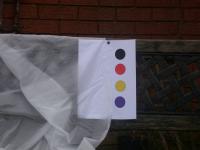Printable Version of Topic
Click here to view this topic in its original format
Unmanned Spaceflight.com _ Mars Express & Beagle 2 _ Beagle 2 in HiRISE
Posted by: elakdawalla Feb 14 2007, 05:04 PM
EDIT: Moved these posts from the http://www.unmannedspaceflight.com/index.php?showtopic=3916 thread to here to collect all Beagle 2 search related stuff in one place.
I'm downloading them now too -- guess I can't blog about them until I've examined them very carefully!
For a bit of history on the search,
Here's http://www.planetary.org/blog/article/00000321/ a while ago
Here's the http://www.msss.com/mars_images/moc/2004/08/31/
And here's the http://news.bbc.co.uk/1/hi/sci/tech/4542174.stm
EDIT: and here's my http://www.planetary.org/blog/article/00000858/ split up into 40-MB chunks.
--Emily
Posted by: Zvezdichko Feb 14 2007, 05:28 PM
Hmm...after a quck glance nothing on these pictures seems to be a sign from Beagle. Otherwise, the crater is indeed an interesting feature. Look at the walls - what could this be? Hematite?
Posted by: elakdawalla Feb 14 2007, 06:30 PM
There are two HiRISE images labeled as being Beagle 2 related sites. One of them, http://hiroc.lpl.arizona.edu/images/PSP/diafotizo.php?ID=PSP_002347_1915, clearly crosses the ellipse, and includes the dark crater imaged by MOC. The other one, http://hiroc.lpl.arizona.edu/images/PSP/diafotizo.php?ID=PSP_002136_1920, is centered 0.1 degree of latitude north and 0.2 degrees of longitude east, or about 6 and 12 plus or minus 3 kilometers north and east, of the first one. I am having a hard time locating this on the best MOC context image I can find. Is it out of the ellipse drawn by the MOC team?
Here is the MOC ellipse at 30 m/pixel:
Here is 2347_1915 at 30 m/pixel:
And here is 2136_1920 at 30 m/pixel:
--Emily
Posted by: Zvezdichko Feb 14 2007, 07:28 PM
So... it's sure that Beagle 2 is not in this area... or am I wrong?
Posted by: djellison Feb 14 2007, 07:32 PM
Well - I've not looked at every sq. foot of the >1GB that those two images include....but I intend to.
Doug
Posted by: Zvezdichko Feb 14 2007, 07:57 PM
Doug
Doug, can you recommend me a good jp2 viewer? Do I have a chance to open this with an ancient hardware - CPU 800 Mhz, 192 ram?
Posted by: djellison Feb 14 2007, 08:49 PM
Sorry to be brutal - but with that spec, it's just not worth it. I use a package recommended here - http://hiroc.lpl.arizona.edu/images/jp2.html - called OpenEV. 1.7 Ghz Centrino CPU and 2 Gb of ram is barely enough.
Doug
Posted by: elakdawalla Feb 14 2007, 08:52 PM
I am working on cutting up the part of the .jp2 that crosses the ellipse into more manageable chunks of 30-40 MB each in PNG format. I'll post those on the blog by the end of the day today, so if your computer or your modem (or your patience) can't manage the 800 MB .jp2 files, wait for those.
--Emily
Posted by: djellison Feb 14 2007, 10:01 PM
One of them's easy to place - but not t'other - is it even in this shot?
edit....found it - and updated the JPG.
Doug
Posted by: AlexBlackwell Feb 14 2007, 10:07 PM
Notice what apparently is a large boulder/ejecta block at the 11 o'clock position of the crater. I'm reminded of http://www.apolloexplorer.co.uk/photo/html/as16/10075857.htm at the Apollo 16 landing site.
Posted by: djellison Feb 14 2007, 10:17 PM
A small house - I make that rock approx 1m across ![]()
This bright rock is on the northern inner slope of the larger crater just to the east - 6.5 metres across...that's more housey ![]()
Posted by: AlexBlackwell Feb 14 2007, 10:21 PM
Okay, then Outhouse Rock, which was a smaller rock immediately adjacent to House Rock at the Apollo 16 site.
Or, given the size, perhaps "Doghouse Rock"
Posted by: djellison Feb 14 2007, 10:35 PM
To be fair you posted a link to "http://www.apolloexplorer.co.uk/photo/html/as16/10075857.htm"![]()
Doug
Posted by: AlexBlackwell Feb 14 2007, 10:46 PM
Actually, the rock in that photo depicted in that photo isn't House Rock, which was much larger.
Posted by: djellison Feb 14 2007, 10:50 PM
I know - that's what the caption says. ![]()
Doug
Posted by: AlexBlackwell Feb 14 2007, 10:53 PM
I lost track of the scale because I forgot I was looking at a HiRISE image instead of a MOC NA image.
Posted by: AlexBlackwell Feb 14 2007, 10:57 PM
Emily has a new http://www.planetary.org/blog/article/00000858/.
Posted by: elakdawalla Feb 14 2007, 11:00 PM
...and it contains the links to the pieces of the one HiRISE image that crosses the ellipse. Go have a look and see if you can find anything interesting!
Emily
Posted by: dvandorn Feb 15 2007, 03:13 AM
Outhouse Rock was indeed the smaller rock (roughly the size of an outhouse) that had split off from House Rock. Interestingly, while Charlie Duke christened the large rock House Rock ("Well, that's your House Rock, right there"), he made it sound like they had talked about finding "rocks the suize of houses" pre-flight, but according to all of the interviews I;ve read, they hadn't -- Duke just came up with the name on the fly.
That said, I bet there are tons and tons of house-sized rocks on Mars... ![]()
-the other Doug
Posted by: Zvezdichko Feb 15 2007, 08:10 AM
Thank you, Emily! The chunks will help us a lot.
Posted by: nprev Feb 15 2007, 09:04 AM
Does anyone happen to know the IR characteristics of Beagle 2's chute, solar panels, etc.? I've got this imagery software called ENVI on a temp license for a class, and would like to try looking over these chunks with it.
Thanks! ![]()
Posted by: djellison Feb 15 2007, 10:11 AM
When I get home tonight I'll check if any specific materials are used in the 'chute or airbags - but I would expect them to be fairly identical to MER. The airbags were made by the same people for instance. The book I referenced in the simulation image is essentially THE opus on Beagle 2. If it's not in there, it's probably not in the public domain at all.
Doug
Posted by: ustrax Feb 15 2007, 10:38 AM
I have a candidate for the heatshield... ![]()
http://i16.photobucket.com/albums/b14/ustrax3/b2hs.jpg
From the image I post (not the best quality I know...) it might not look so different from any other rock but if you check Emily's full image (bottom row, center), you'll see that this specific spot (located approximately at 12h inside the big crater on the left center of the image) looks more "shiny" than the surrounding features.
The problem is that I don't find anything resembling other components...
I'll keep looking...
Posted by: djellison Feb 15 2007, 10:45 AM
Starting a thread for possible B2 stuff within HiRISE images...I think it needs its own thread.
People may find these usefull..
http://video.beagle2.com/Descent/play_descent_a_640x368.htm
http://video.beagle2.com/Landing/play_landing_b_640x368.html
Posted by: ustrax Feb 15 2007, 10:47 AM
Doug
From your 3D rendering I would change my candidate from possible heatshield to possible Beagle 2... ![]()
Posted by: djellison Feb 15 2007, 10:54 AM
Fair play to you - it's an interesting target.
The thing I think we need to be careful of is that these images are re-projected and so any single cosmic-ray event or anything else of that nature (as shown here - http://hiroc.lpl.arizona.edu/images/2007/details/cut/PSP_002136_1920_cut_b.jpg ) might - even if only a single pixel in the downlinked image - show itself as more than a pixel in a reprojected image.
That said - I've done a comparison between that target and the the heatshield in my sim - and it's not a million miles apart. I do my sim's at 33cm/pixel now - it just seems more realistic in terms of resolving power - so I've upscaled my 33cm/pixel render to 25cm/pixel and put it side by side.
I personally don't expect to see a deployed B2 on the surface. If it were there, I would expect to see a very obvious chute nearby, as well as airbags.
Posted by: ustrax Feb 15 2007, 11:07 AM
My point too Doug...
And thanks for the images, that's precisely the place I was talking about!
While you were doing you're comparison I was entertained with http://i16.photobucket.com/albums/b14/ustrax3/b2lls.jpg...
(I've rotated your rendition 90º to the left)
So...If it not deployed how would it look like?...
Posted by: djellison Feb 15 2007, 11:15 AM
Depends how much of the EDL sequence worked.
Burnt up during entry : Nothing on ground
Survived re-entry but dead on arrival : that estimated crater size
Main Chute deployed but no airbag inflation - Large chute, probably a small 'splat' mark nearby.
Chute deployed - airbags inflated but B2 died on impact - Large Chute, one large composite airbag mess of all 3 bags.
Everything worked but B2 didn't open and deploy - Large chute, three airbag lobes, and an unopened lander would look fairly similar to the heatshield alone I would guess. HOWEVER - that would suggest some sort of failure after a great landing but before deployment and I find that a hard scenario to believe.
I think you're probably reading too much into a probably imaging artifact - BUT - it's certainly on the list of 'hmm - interesting'
Also - be carefull of rotating things. I set the lighting in that simulation to match the average lighting for HiRISE looking at near equatorial sites. I've not adjusted it to exactly match the parameters of the image we're looking at - but it's there or there abouts. Rotating things puts the shadow in a different place etc etc.
Doug
Posted by: ustrax Feb 15 2007, 11:31 AM
Yes, probably...as usual...
I'll just let the masters work...
Posted by: prometheus Feb 15 2007, 12:38 PM
Beagle Splat?
Looks like the main chute didn't fully deploy and Beagle 2 hit hard.
Posted by: ustrax Feb 15 2007, 12:46 PM
Could you give a more exact location?
Posted by: djellison Feb 15 2007, 01:15 PM
You're zoomed out by about 5x... to give you a sense of scale - this is at 100% - and is the area you mark as 3 airbags is actually two small craters and a pile of rocks. what you mark as Heatshield is infact a bright dune.
Doug
Posted by: prometheus Feb 15 2007, 01:25 PM
Are we looking at the same area?
Posted by: djellison Feb 15 2007, 01:31 PM
Yes - you're zoomed out a huge ammount - perhaps firefox has downsized the image to fit in your browser window?
Doug
Posted by: prometheus Feb 15 2007, 01:37 PM
I used Stereo Photo Maker with the 2.5 Mb jpg image. Will download the jp2 and check again. I guess you have done that. Pitty that, it was all there, in a line and what one would expect of a very vertical rapid foiled chute descent.
The three rocks around the dark cross shape with an attached medium bright rock sure looks interesting.
Posted by: prometheus Feb 15 2007, 01:55 PM
I used the wrong image scale. Sorry for that.
Posted by: ustrax Feb 15 2007, 03:04 PM
I know that I promised to stand still and I also know that you guys are not great fans of this kind of pseudo-perspective but I couldn't avoid it... ![]()
http://imageevent.com/spaceurope/beagle2?p=0&b=-1&m=24&c=4&w=4&s=1&n=1&l=0&z=9
It looks to me that the spot I indicated is not an artifact, if you look to this image it looks like there is a crater under it and some shadowing.
This also helps me imagine how painful might have been Beagle's end...
Who knows if it might just crumbled down the hill on it's back, does anyone see a parachute there? ![]()
Posted by: ugordan Feb 15 2007, 03:10 PM
What do you gain by reprojecting the image like that, Ustrax?
That bright feature (artifact ?) does look interesting, though. Still, it seems like a lucky shot to be finding it in the first of the strips covering the entire landing ellipse.
Posted by: ustrax Feb 15 2007, 03:15 PM
ugordan, some sense of perspective I don't get with the original one...
It would REALLY be a lucky shot, as I told previously it is just a candidate...
But hey! If it was http://www.planetary.org/blog/article/00000321/... ![]()
Posted by: djellison Feb 15 2007, 03:22 PM
THERE'S YOUR PROBLEM.
Instead of looking at a 2048 x 4983 image - get the full-fat 812Mb 28247 x 68730 image
Doug
Posted by: djellison Feb 15 2007, 05:12 PM
After The BA mentioned Emily's blog entry about this HiRISE image - Andrew commented on a feature that I've pulled out of PSP_002347_1915_RED_r2c3.png - Alex will be calling it house rock before too long although to be fair - that segment off to the left does look like the orange-segment sort of shape one would expect from the airbags....BUT....if the vehicle was healthy enough to fire the pyyros to drop away from the airbags - one would expect a working vehicle on the surface.
The 'killer find' still has to be either the 10m diameter parachute or a fresh crater + debris.
Posted by: ElkGroveDan Feb 15 2007, 05:49 PM
Which is why I think we won't have a problem identifying it when it's imaged - it just hasn't been imaged yet. There's a whole lot of that ellipse that still needs examining. I'm guessing it's up-range.
Posted by: elakdawalla Feb 15 2007, 05:54 PM
Why up-range? Wouldn't it be down-range if parts of the EDL system (especially the parachute) didn't work correctly? ![]()
--Emily
Posted by: ElkGroveDan Feb 15 2007, 06:18 PM
I wasn't pegging it the failure on EDL malfunctions. I was thinking of atmospheric aberrations as the cause. (But I haven't really put a lot of thought into it.)
Posted by: elakdawalla Feb 15 2007, 06:45 PM
As it turns out, the atmospheric aberrations caused both MERs to land downrange of the centers of their ellipses, so Beagle 2 probably would have done the same (which is why the MOC imaging campaign focused on the eastern half of the ellipse). I don't have any idea what effect EDL malfunctions might have had -- I'm guessing they would also have resulted in a downrange bias but I don't have a clue what the magnitude of that would be, whether 1 or 10 kilometers or more.
--Emily
Posted by: ElkGroveDan Feb 15 2007, 06:52 PM
Then I guess I'll only throw down a few small chips on that up-range bet ![]()
Posted by: Littlebit Feb 15 2007, 07:48 PM
http://imageevent.com/spaceurope/beagle2?p=0&b=-1&m=24&c=4&w=4&s=1&n=1&l=0&z=9
It looks to me that the spot I indicated is not an artifact, if you look to this image it looks like there is a crater under it and some shadowing.
This also helps me imagine how painful might have been Beagle's end...
Who knows if it might just crumbled down the hill on it's back, does anyone see a parachute there?
This is certainly a good candidate - If I understand Doug's scaling, the crater is about the right size for a Beagle splat. Spirt's parachute just barely deployed in time to save a similar fate, so splat it could be.
Posted by: ustrax Feb 16 2007, 02:56 PM
Here I am again... ![]()
I grabbed Beagle's last known image and used it in a http://imageevent.com/spaceurope/beagle2?p=1&b=-1&m=24&c=4&w=4&s=1&n=1&l=0&z=9.
It has some similarities with http://www.unmannedspaceflight.com/index.php?act=Attach&type=post&id=9349 but quite different from his http://www.unmannedspaceflight.com/index.php?act=Attach&type=post&id=9351.
I also added Beagle 2 dimensions, can anyone tell me if the spot's pixels match those?
Posted by: ugordan Feb 16 2007, 03:07 PM
I have to say, that bright object seems to be too bright to be an ordinary rock. It's also slightly blurry which a cosmic ray artifact wouldn't be. I think it's not too far-fetched to suggest that might really be a manmade object. Whether it's the lander itself or a piece of it, who knows?
Then again, maybe it's just one of them iron meteorites...
Posted by: djellison Feb 16 2007, 03:58 PM
Remember - a cosmic ray hit might be a single pixel in the collected data - but it will 'grow' over multiple pixels during map projection.
Also...
http://hiroc.lpl.arizona.edu/images/2007/details/cut/PSP_002136_1920_cut_b.jpg
There's nothing about the Ustrax target that elimiantes it from being an imaging artifact.
Attached - applying perspective distortion in photoshop on a single white pixel - first just in one direction, then in two directions. See how the dot 'grows'. I don't know how the map projection for HiRISE works - but I imagine it would introduce similar artifacts.
Doug
Posted by: ugordan Feb 16 2007, 04:06 PM
The point about map projection certainly holds. My opinion is still that it's a real feature, not an artifact.
Posted by: ustrax Feb 16 2007, 04:10 PM
My oppinion too ugordan, mostly due to the fact that the feature looks like is casting shadow.
But, of course...Doug (from the Cosmic Ray Preservation Fund...) can be right... ![]()
EDITED: Doug, as I asked before, do the feature dimensions match the Beagle 2 ones?
"There's nothing about the Ustrax target that elimiantes it from being an imaging artifact."
And the opposite? ![]()
Posted by: djellison Feb 16 2007, 04:13 PM
As the simulation shows - it would be the right sort of size for the heatshield or backshell or unopened lander - but a deployed lander I would expect to look different. If you were to say "this IS a bit of Beagle 2 - which bit?" - I would say the heatshield. But - if you ask which is more likely - 800 megapixels having the odd imaging artifact or a piece of B2 indicative of the spacecraft making it through entry and deploying it's heatshield but later failing, and that heatshield being visible in the first HiRISE image of the landing ellipse....I'd say cosmic ray hit. I'm not saying it isn't a chunk of spacecraft - and it really does look like a chunk of B2. What I'd like is a HiRISE image targetted directly west of this one - a tiny bit of overlap - but I would expect the 'chute to be back up the trajectory and thus west of the heatshield (same was true of Spirit and Opportunity if you think about it.)
Until we see either a fresh crater or a main chute - I don't think it's wise to say we've found any Beagle hardware - we've simply found interesting targets.
Just thinking out-loud again - the TDI CCD's on HiRISE, there's plenty of scope for a single cosmic ray hit to actually take out a few pixels in one go - 128 lines to have a stab at for each 'finished' pixel if you think about it.
Attached - an extract from the mission report which you can find at http://www.src.le.ac.uk/projects/beagle2/reports.html
Suggestive that the heatshield might be somewhere around 150m downrange from the rest of the vehicle...of course drift under the chute and bouncing around could obviously change that significantly.
Doug
Posted by: ugordan Feb 16 2007, 04:14 PM
If only someone could sneak us the raw, non map-projected image...
Posted by: hendric Feb 16 2007, 04:37 PM
Doug,
Have you tried map-projecting your simulations?
Posted by: djellison Feb 16 2007, 04:43 PM
There wouldn't be much point - I don't know enough about the map projection parameters to even make a sensible guess. rendering at 33cm/pixel and then resizing to 25cm is going to introduce some of the 'softness' that reprojecting might induce.
Doug
Posted by: tuvas Feb 16 2007, 05:03 PM
You wouldn't want a raw image, those a pre-cal;-) But I might be able to sneak a small part of one of the artifacts in one of the images, if you give me some pretty good ideas as to where to find it.
Posted by: ugordan Feb 16 2007, 05:07 PM
Well, having a sample of the artifacts wouldn't do much good as we already have that in the latest release. Ideally, the same region we're looking at here is the one we're interested. That must be a pain to locate in the calibrated, non-projected images though...
Posted by: ustrax Feb 16 2007, 05:29 PM
Who's saying that?
I, like you, would like to see full confirmation about the nature of the feature, to, in the case of being a cosmic ray, just move to other locations.
Posted by: kenny Feb 17 2007, 10:12 AM
Alex is correct. That is a smaller rock beside House Rock, just to the south of it.
http://spaceflight.nasa.gov/gallery/images/apollo/apollo16/html/as16-116-18653.html
Kenny
Posted by: Ames Feb 17 2007, 11:52 AM
Not sure about this one but it looks different to the surrounding features.
Either casting a long shadow or disturbed ground exposing dark subsurface.
http://farm1.static.flickr.com/154/392846173_af5a902f21_o.jpg
There are just sooo many rocks that could be airbags, soo many faint craters that look like a parachute.
I am just trying to find anything disturbed, dark, like the splat that oppy's backshell made.
Posted by: Sunspot Feb 17 2007, 12:16 PM
That feature looks quite interesting actually. Is it a 100% crop? Is it my imagination or are the faint "rays" coming from it?
Posted by: Ames Feb 17 2007, 12:45 PM
Yes 100%
http://farm1.static.flickr.com/77/392880515_de61f9a3d4_o.jpg
Red dot marks the spot
From Emily's blog;
http://planetary.org/blog/article/00000858/
Posted by: djellison Feb 17 2007, 01:19 PM
Looks like a shadow behind an unusual shape rock. An impact splat would be larger than that (i.e. the best B2 team estimate is approx the crater size I show in my simulation ) - but it's another 'hm - interrsting' target.
A chute will always be very very obvious. The MPF chute is so very obvious nearly 10 years after landing. The MER chutes were very very easy to find - the B2 parachute if it deployed will be similarly obvious - despite being a much smaller lander, it used a similar sized chute ( because it had no retro rockets ) -
Attached is the 'all my hardware' playground for the 3d sims. It's all been seen before - but this shot ( at 33cm/pixel) shows the B2 stuff top left as seen here - then three sets of 'chute - backshell and heatsheild on the right which, from left to right, are Viking, Pathfinder and MER.
B2's chute design was a different shape to the JPL vehicles - but it's a similar size.
The three scenarios I'm interested in are...
1) Burnt up on entry due to unstable aerodynamic design. This is actually what I think is most likely given that the B2 capsule was a significant departure from the 'heritage' of Viking and MPL and actually used the Huygens heatshield shape which makes no sense imho - 1.5bar N2 compared to .05 bar CO2 - very different challenges. If this happened - we'll find nothing in HiRISE ( for a comparison - have we found any MER cruise stage... no )
2) Didn't burn up - but was dead on arrival and simply had a lithobraking impact that would produced a crater as simulated and documented in the B2 report. This would be very obvious in HiRISE imagery imho - MGS has shown us that recent craters are fairly obvious - so HiRISE would see this very clearly - but I would expect this to be at the eastern end of the ellipse if not beyond ( I want to ask the B2 team about this actually - what scenario that ellipse is for ) as there would be no deceleration from drogue or main chutes.
3) Survived entry and then deployed the drogue and the main chute. If we're going to find ANYTHING else - this HAS to have happened and so personally - before considering candidate hardware that isn't a crater - I want to see a chute first because it's a prereq of seing a heatshield (which deployed after the main chute) - a lander or any airbags on the surface.
This is the first sensible thing to search for...
http://www.planetary.org/image/hirise_pathfinder_backshell_crop_200pct.jpg
(ignoring the backshell)
Doug
Posted by: Sunspot Feb 17 2007, 02:00 PM
OK heres your "spot" resized up by 500%
How many of you have gone through the whole HiRISE image?
Posted by: Ames Feb 17 2007, 03:10 PM
Yep, propbably just a rock
This one is a little different
http://farm1.static.flickr.com/157/392968027_0fde0bc79f_o.jpg
Sunspot, I have been over the whole of PSP_002136_1920_RED.jp2 and am running out of initial targets. Beagle2 is probably not in this set of data. I think this is all just a bit of practice for when we get some swathes from downrange a lttle.
Posted by: JTN Feb 17 2007, 03:51 PM
FWIW, I've http://www.chiark.greenend.org.uk/~jacobn/mro/ one of the Beagle 2 ellipse HiRISE images. (I was unable to convert the larger one successfully, for some reason, even if I split it up.)
Although given that the Zoomifyer output takes up only 50-60% of the space of the original JP2 even though it's multiply redundant, I'm not sure how much use it is for looking for features at the limit of resolution...
Posted by: Sunspot Feb 18 2007, 12:26 AM
Are there plans to take more images of the landing site?
Posted by: AlexBlackwell Feb 23 2007, 06:47 PM
I don't know if this press release was mentioned but in case it wasn't:
http://www.pparc.ac.uk/Nw/mro_crater.asp
Particle Physics and Astronomy Research Council
Swindon, U.K.
16 February 2007
Posted by: djellison Mar 7 2007, 09:14 PM
Emily pointed out that the Isidis image for Osiris cross-calib just caught the end of the ellipse so I have added it to 'the mix', presented here at 30m/pixel.
Doug
Posted by: FIN Mars Oct 24 2008, 02:58 PM
Beagle 2 Back Shell and Parachute?
Probably not, but still...
Posted by: djellison Oct 24 2008, 03:27 PM
Which image and what coords is that from? I woudl concur - very very unlikely, that backshell feature is too large, by about 2x.
Doug
Posted by: FIN Mars Oct 24 2008, 04:51 PM
Doug
at the Emily Lakdawalla's website it is picture> Top row, right (20 MB)
http://www.planetary.org/blog/article/00000858/
Object is very close down side and near left side of the picture. Crater nearby object should be find relatively easy.
Sorry my english skills, hopely you undestood something...
do you know when we get more HiRiSe pictures of the landing side?
Posted by: Sunspot Dec 17 2008, 08:23 PM
Beagle 2 may have tumbled to a fiery doom
http://www.newscientist.com/article/mg20026876.500-beagle-2-may-have-tumbled-to-a-fiery-doom.html
Posted by: djellison Dec 17 2008, 09:16 PM
Two things have always put an entry-phase burn-up top of my list of Beagle 2 failure modes. Firstly, the lack of any parachute visible in MOC imagery (which would be very very visible) - and secondly - the fact that the B2 shape was Huygens like rather than Viking like.
Doug
Posted by: rlorenz Dec 18 2008, 02:19 PM
Eh? Huygens worked - not sure I follow.
Havent read this new australian paper yet ; I always liked the ammonia-leaked-out theory
Posted by: mchan Dec 18 2008, 04:32 PM
It could be that a shape designed for the thicker Titan atmosphere may not work as well for thinner Mars atmosphere as a shape designed for thinner Mars atmosphere.
Posted by: djellison Dec 18 2008, 04:51 PM
.01 bar CO2 vs 1.5 bar N2 - there was a chap over at The Habitable Zone who was fairly convinced that Beagle looking more like a small Huygens than a small MPF was a recipe for high mach number problems.
Posted by: ugordan Dec 18 2008, 05:52 PM
In all fairness, you can't compare surface conditions to entry conditions both probes experienced. Huygens entered at what, 6 km/s and isn't that a typical Mars entry velocity, too?
The bigger difference could have been entry angle, but even then if you had two identical probes on the outside and their centers of mass were located differently, they could behave entirely differently. A Huygens-lookalike probably isn't a bad thing by itself.
Posted by: dvandorn Dec 18 2008, 06:34 PM
As I understand it, though, what's now being speculated is that Beagle 2 failed to successfully cross transition boundaries, not that the heat shield failed during the heat pulse. The shape of the entry vehicle is critical to how the vehicle maintains stability through hypersonic to supersonic velocities, and there are a lot of factors, including the actual atmospheric deceleration rate, that affect how the shape and the regime interact.
Huygens continued to decelerate at a faster and faster rate as it dug into Titan's thicker atmosphere. Beagle 2 continued moving faster for longer after it hit its maximum deceleration (which would have been less decel than Huygens saw, since Mars' atmosphere doesn't thicken with depth to the extent that Titan's does). I would be extremely surprised if Huygens and Beagle 2 were traveling at similar airspeed velocities a minute after the end of peak heating.
You would have to plug in speed, deceleration rate and air density throughout the descent profile for each probe to determine the differences in transition boundaries between the two events. I guess what I'm thinking is that Huygens was slowed more quickly and effectively, and thus plowed through the transition boundaries very quickly, with very little time for the vehicle to become unstable (and, as I recall, there *are* some indications that Huygens tumbled briefly at some points during its descent). Because of the thinner air, Beagle 2 slowed more slowly and spent more time passing through transition boundaries than Huygens did, thus increasing the possibility that both its spin rate and any inherent instability in the aerodynamics of the vehicle's shape would cause the craft to tumble while still in a fairly challenging heating regime.
Make sense?
-the other Doug
Posted by: Doc Dec 18 2008, 07:22 PM
Perfectly Doug! But the question now is what the hell persuaded the B2 team to install the Huygens shield? Honestly this is one of the reasons why someone should come with a standard issue book titled 'How to land on different worlds for idiots!'
Posted by: mcaplinger Dec 18 2008, 07:24 PM
I believe it's a lot more involved than that, since we are talking about fluid dynamic regimes where gas properties are far from ideal, etc, etc. Designing these things is still a black art (literally; I think many aspects of RV design are still classified.)
That said, the Beagle entry design was done by engineers at EADS, and one presumes they had some basis to think it would work. It's not as if they picked the Huygens shape with no justification. My limited understanding is that the RV shape is at least partly a matter of tradition and heritage, not strongly engineering-driven.
Posted by: Enceladus75 Dec 18 2008, 08:27 PM
So the evidence from new analysis is pointing to an atmospheric burning up for the ill fated Beagle 2. If that truly was the fate of B2, then there can't be any chance of HiRISE finding anything on the Martian surface at Isidis.
It's a darn shame...why was the Huygens aeroshell selected? Did the engineers not realise that the atmospheric dynamics at Mars would be completely different to that of Titan? This appears to be almost as bad a gaffe as the Mars Climate Orbiter mix up of metric and imperial units. Again, I suspect penny pinching and keeping costs cut to the bone was the main problem - Beagle 2 was underfunded - too fast and too cheap! ![]()
Posted by: mcaplinger Dec 18 2008, 08:45 PM
Did you read my last post? You guys are way too eager to jump to conclusions without much knowledge of the engineering realities involved. I haven't seen a detailed analysis of the Beagle aeroshell design, but certainly the independent JPL review said nothing about this, so if it was an error, it was a subtle one, not a stupid and obvious one.
Posted by: Enceladus75 Dec 18 2008, 08:57 PM
OK I take your point, mcplinger...but please, no need to jump down the throats of us lesser mortals who are not aerospace engineers.
I do still hold to my belief that a very limited budget and limited resources to the B2 team was what ultimately contributed to Beagle 2's demise on Mars. As I've heard the saying, you can have two of the three ..."faster, better, cheaper" ... any two, but not all three.
Posted by: climber Dec 18 2008, 08:58 PM
A bit OT but anyway, do you know if Phoenix EDL reconstruction help assuming MPL's "ED" must have been nominal so we can assume only "L" failed?
Posted by: Stu Dec 18 2008, 09:02 PM
As the Phoenix team went to great pains to point out as we crept towards EDL, landing on Mars is hard... incredibly hard... teeth-gnashingly, hair-pulling-out hard. I don't think we know what went wrong with Beagle yet, this is just another New Best Guess.
And as the Beagle team had to fight their way through ten different levels of Hell to even get the probe built and taken to Mars, and the probe they designed and built with little support from any Big Money, was a marvel of engineering, "as elegant as a pocket watch" it has been said. If it had worked they'd have been praised to the skies for "exploring Mars on a shoestring" and "upstaging NASA for a hundredth of the money"... Hindsight is always 20/20, and yes, mistakes were probably made, but denouncing them as 'idiots' is very unfair I think.
I spent that fateful Christmas Day going online every twenty minutes, desperate for updates. I had a horrible, sick feeling in my gut all day waiting for news, with hope gradually ebbing away... and if I was that bad, what nightmares the Beagle team experienced I don't like to imagine.
Idiots? Never. I'm still proud of them for even trying.
Posted by: mcaplinger Dec 18 2008, 09:36 PM
Here's the Casani report for people who feel like reading it. Note section 6.2.2 in particular.
http://www.bnsc.gov.uk/5278.aspx
Posted by: Doc Dec 18 2008, 09:41 PM
Don't you worry Stu, I vented my anger a long time ago on the UK gov't who were supposed to nurture the mission if you will. The B2 team are alright. (seeing that you are british I hope I didn't offend you ![]() )
)
Posted by: nprev Dec 18 2008, 09:51 PM
Well said, Stu.
It should also be noted that in engineering we sometimes learn more from failure than from success. Analysis of failure modes often refines (or even defines previously unknown) top-level system performance constraints and inevitably leads to better designs. In that light, B2 is still making a significant contribution to solve the fundamental engineering problem 'how to survive EDL on Mars'.
Certainly not as satisfying as a successful mission would have been, but nevertheless a net gain in human knowledge was realized from B2.
Posted by: sci44 Dec 19 2008, 12:25 AM
According to the article, Beagle hit at mach 35, around 12 km/s - it detached prior to orbital insertion, to save MEX a bit of delta-V. For us lesser beings reading this thread, the http://en.wikipedia.org/wiki/Atmospheric_reentry on atmospheric re-entry is actually pretty decent.
http://www.bnsc.gov.uk/5278.aspx
That is interesting - plenty of critisism but on aeroentry the report states "Both the quantity and quality of the work performed are outstanding."
They were asked to reduce weight from 108kg to 60kg in 1998, and less mass has to mean more susceptibility to any chaotic forces on entry.
On another thread on MEX/B2 I mooted the idea of sending Beagle-3 on an SEP first stage - it could be delivered to GTO as a mission of opportunity (like SMART-1), and take its time to spiral to Mars. An SEP stage would allow a larger delivered mass - indeed as a first ever use of such a delivery method for a planetary craft, it could be seen as a test mission. This time EDL comms would be a must too..
Only this time, instead of Blur, we should ask Monty Python to sponser the mission. Beagle, as part of its EDL, should broadcast "The Liberty Bell" during descent, with the big foot coming down at the time of its landing!
Posted by: Paolo Jan 2 2009, 11:54 AM
http://www.newscientist.com/article/mg20026876.500-beagle-2-may-have-tumbled-to-a-fiery-doom.html
Journal of Spacecraft and Rockets paper now available for free
See the AIAA siteof the journal under http://www.aiaa.org/content.cfm?pageid=322&lupubid=25&sItem=6.
There is also a paper on Stardust's reentry available for free
Posted by: rlorenz Jan 2 2009, 03:05 PM
Readers might also be interested in a review I did a couple of years ago on spin of
planetary probes (emphasis was on descent, rather than entry, but it touches on it
and summarizes the various spin rates and spin-separation-umbilical designs used.
http://www.lpl.arizona.edu/~rlorenz/spinjbis.pdf
I have to say in the process of researching this, I find it very difficult to find
*pre-Mission* calculations of release spin rates for entry vehicles. Notionally the
spin rate should be chosen based on angle of attack tolerance at the entry
interface (which in turn depends on targeting accuracy, as well as the moment
of inertia, the expected disturbance torques and the coast time) as well as
dynamic stability during the entry itself (the subject of this paper). While there
are always post-mission reconstructions etc., I haven't come across a paper
saying 'This is the spin rate we chose and this is why'. (Maybe because of fear
one gets it wrong..?)
This Beage/J.Spacecraft paper may be getting more attention than it deserves -
I can't see any obvious problems with it, but the main message is 'look, here is a
simulation that diverges in the transition regime'. It would be more useful to
show that the same simulation code yields survivable entries for MPF, MER etc.,
and to show what the 'correct' spin rate for Beagle should have been (if, indeed,
any spin rate would have worked....)
A complex problem, verging (as another poster noted) on a black art.
Posted by: sci44 Jan 3 2009, 03:14 PM
Well the Beagle 2 mission scientists (Pillinger, Smith) themselves remain http://news.bbc.co.uk/1/hi/sci/tech/7788638.stm
(Pillingers quote at the end of that piece is priceless!)
Posted by: Zvezdichko Jan 3 2009, 09:09 PM
By the way, while I respect you opinion, I think that you are wrong.
I have read the report and thousands of critical articles. The British team is very ambitious, but I have the feeling that they always blame the environment. Firstly, the big crater, secondly, the thin atmosphere.
Posted by: sci44 Jan 3 2009, 11:24 PM
I have read the report and thousands of critical articles. The British team is very ambitious, but I have the feeling that they always blame the environment. Firstly, the big crater, secondly, the thin atmosphere.
Well, I am sure you could be right - there *could* be other engineering issues with Beagle-2 beyond "bad luck" factors like landing on the side of a crater, or the atmosphere being too thin. We will never know for sure without EDL data, and I would expect EDL comms would be high on the list for B3. I will not re-iterate everything else from this and other B2 threads - you can even consider sheer dead weight as being a factor - in 1998 the Beagle-2 team had to reduce the allowed probe weight from 108kg to 60kg - from pure engineering intuition, a lump of lead might be less susceptible to chaotic forces than a light object.. My real point is, why give up on the first go?
And at that point - you turned to discussing politics. That is a banned subject at UMSF. That has been deleted, as has the reply - Admin.
Posted by: djellison Apr 15 2009, 02:30 PM
Something I learnt from Mark Sims (Beagle 2) last week. Beagle's parachute, which is the big clue I've been looking for in MOC and HiRISE imagery... was fairly transparent, and sort of beige.
Posted by: Phil Stooke Apr 15 2009, 03:41 PM
That's going to make it a lot easier! ![]()
Memo to future mission planners: make parachute visible...
Phil
Posted by: ElkGroveDan Apr 15 2009, 03:49 PM
A http://www.unmannedspaceflight.com/index.php?showtopic=5945&view=findpost&p=139120 we were having last night
Posted by: djellison Apr 15 2009, 04:25 PM
That's what triggered me to post this ![]()
Posted by: PhilCo126 Apr 16 2009, 06:54 AM
Indeed parachutes should be made in Orange/White "Search & Rescue" color scheme otherwise these are untraceable.
Then again when these are tested, engineers are on the spot and don't have to search for it ![]()
Take a look at this test, the parachute is well camouflaged:
Posted by: imipak Apr 16 2009, 09:06 PM
I give up; what (and where) on earth is it?
Posted by: Hungry4info Apr 16 2009, 09:46 PM
It's the Orion parachute test. The parachute failed. I don't know where it is though.
Posted by: ElkGroveDan Apr 17 2009, 02:09 AM
It's not California, maybe Arizona or New Mexico by the look of the soil.
Posted by: nprev Apr 17 2009, 02:42 AM
That mountain range looks awfully familiar...Indian Springs, Nevada area (NW of Vegas)?
Posted by: Cugel Apr 17 2009, 09:17 AM
Yuma Proving Grounds in Arizona on July 31, 2008.
Posted by: PhilCo126 Apr 17 2009, 09:49 AM
Indeed Yuma Proving Grounds in Arizona near the Mexican border in the Sonora desert.
The Orion capsule (6500 Kg) parachute system uses two drogue chutes to stabilize the craft, then these two are cut away in order to deploy three pilot chutes, which each pull out one of the three main 35-meter diameter parachutes that are meant to ensure a safe landing speed. In compariosn, the Russian Soyuz (2800 Kg) only uses a single 35.5-meter white/orange main chute.
What was the size of Beagle 2 chute?
Posted by: MahFL Apr 17 2009, 02:00 PM
Not orange !!!mars is red/orange. Indigo green is what you need with white circles.......er not frost pockets...... ![]()
Posted by: PhilCo126 Apr 17 2009, 03:07 PM
Beagle 2's main 28 panelled parachute had a diameter of 10 meters and had 11.4 meters rigging lines with a 30 meter strop underneath.
Initially a disc-gap design was choosen, with a triconal canopy as alternative. Due to the gas-bags speed restriction of 60 Km/Hr (kinetic energy) a ring-sail type of parachute was choosen...
( Source: The Guide to Beagle 2 - CT Pillinger Section 2 The Probe )
Posted by: Stuart H Apr 28 2009, 03:39 PM
Here is an image of the Main Parachute material
Stuart H
Posted by: djellison Apr 28 2009, 05:02 PM
That really is rather transparent isn't it. Does it have much of a reflective kick to it, a shine of any sort?
Posted by: Stu Apr 28 2009, 05:07 PM
Well, that explains it. They clearly used lace curtain material from an indoor market for the parachutes... ![]()
Posted by: nprev Apr 29 2009, 12:34 AM
Wow. I'd characterize that as gossamer! Bet it was very, very light & of course strong, but I almost have to wonder how permeable it was and how that affected deceleration in the lower speed regime.
Posted by: Shaka Apr 29 2009, 05:14 AM
Looks a lot like spinnaker ripstop to me, Nick. Maybe it will win the next America's Cup? ![]()
Posted by: Stuart H Apr 29 2009, 11:03 AM
That is exactly correct.
But it passed every test we could do on Earth. However the big unknown is how it performed on Mars.
Stuart H
Posted by: Stuart H Apr 29 2009, 11:07 AM
Doug,
No it is rather dull on both sides. I have a sample of it at home. If we ever get to meet I'll bring it with me.
Stuart H
Posted by: Shaka Apr 29 2009, 08:23 PM
What grade is it? Bainbridge Force 9?
That only comes in 'natural' color.
Next time dye it as a big Union Jack! ![]()
Posted by: stevesliva Apr 29 2009, 08:55 PM
You mean Beaufort? Someone's got pirates on the mind.
Posted by: Shaka Apr 29 2009, 09:24 PM
Bainbridge is the Force 9 ripstop nylon manufacturer. Their 'heavy seas' weight. (and maybe hypersonic?)
I'm strictly a Dodgers fan. ![]()
Posted by: cbcnasa May 1 2009, 08:14 PM
It does look so thin and pourous how much was it able to slow the craft? ![]()
Posted by: Shaka May 1 2009, 11:26 PM
Spinnaker ripstop nylon has a coating which renders it non-porous.
At least, at sailing yacht windspeeds. ![]()
Posted by: djellison May 1 2009, 11:37 PM
The Beagle 2 book I have is out in the Shed, so I'll double check tomorrow - BUT - ballpark figures...
The parachute, at 10m across, and the lander, at something more like 60kg, combine to give a MUCH lower terminal velocity than MER. More like 40-50mph, than the 150+ that MER would have had without RAD's.
I'll pull out proper numbers tomorrow.
Posted by: rlorenz May 2 2009, 05:02 PM
At least, at sailing yacht windspeeds.
A parachute has porosity on a macro-scale (e.g. in a ribbon parachute, or
the gap in a disk-gap-band chute) and on the microscale (the permeability of the
fabric itself). Both are important in inflation, drag and stability performance :
zero porosity is typically rather bad.
Note that at the low Reynolds numbers characteristic of Mars flight, what looks
like a porous fabric does not, in fact, behave as such since the viscous nature of
the flow reduces the effective permeability.
Posted by: nprev May 2 2009, 06:38 PM
Very cogent explanation, Ralph, thanks! I thought something like that might have been at work.
Somebody on UMSF once described parachute design as a "black art"; I believe it. This is just one more in a long list of often very subtle interdependent variables.
LATE EDIT: This also probably explains why Mars parachutes aren't made in eye-searing high-contrast neon colors for easy orbital identification. Since fabric porosity affects performance, introducing fancy colors by whatever means would doubtless complicate control of that parameter. Never add complexities when they aren't truly needed.
Posted by: Shaka May 2 2009, 06:55 PM
Would you care to elaborate on your concerns?
Stuart H says the material was tested on earth. Can we assume that means appropriate wind-tunnel or drop tests?
Posted by: djellison May 2 2009, 07:38 PM
I wish I could just copy and paste the whole section out of 'The Guide to Beagle 2' - I'll paraphrase the parachute section...
The design was changed after establishing that the airbags would have to be going at less than 60kph. So they shifted to this 10m diameter ring-sail. The finished 'chute had 9 rings of 28 panels making 252 in total. The sails are sewn together in the vertical direction, but only at the corners to the next rows.
Tests seemed to include drop tests in Nevada, drop tests from a Hot Air Balloon near Oswestry, England, A pulley-fed extraction test, and a lorry-pulled test at one of the old airship hangers in Bedfordshire.
Tests predicted the terminal velocity with a lander of 57kg would be 16m/sec (35.8 mph)
Direct quote
"The material which was originally intended for spinnakers, used by racing yachts, is nylon, uncoated by any plasticiser. Instead has been calendared (rolled) to flatten the fibres thus reducing porosity. The fabric weights only 22.8g/m^2"
Posted by: mchan May 2 2009, 08:08 PM
Like it would get ripped to shreds depending on the drag at some density and deployment velocity and strength of material.
The ribbon parachutes used to decelerate nuclear bombs from supersonic speeds appear to be very porous.
Posted by: Shaka May 3 2009, 07:18 AM
This is unquestionably a fascinating case history of engineering trade-offs - and in something as prosaic as a parachute!
(Though, presumably, we could just about choose a spacecraft system at random, and construct a similar saga.)
- COST vs Effectiveness vs Risk of Failure.
- Commercial Off-The-Shelf (COTS) technology vs Specialized Parachute Black Magic (SPBM).
- COTS costs less than SPBM, (OK?), but:
-- How like a yacht spinnaker is a Mars re-entry parachute?
-- How does the non-permeable coating of spinnaker ripstop nylon (SRN) hamper its function in a parachute?
-- How does SRN without its coating improve function, and what is the effect on its strength and durability?
-- How does flattening the uncoated SRN improve its porosity and function, and what is the effect on its strength?
No doubt the list of ponderables could be continued, with reference to weight, bulk, construction, and, yes, even color etc.
It's a game only the Anointed can play with gusto. ![]()
Posted by: gwiz May 3 2009, 10:19 AM
Zero-porosity means all the air entering the parachute has to leave again at the edge. It is difficult to impossible to get this to happen uniformly, and non-uniform edge venting leads to the parachute swinging from side to side.
Posted by: djellison May 3 2009, 10:45 AM
Essentially a macro-scale equivalent to the vent hole in the top of the MER design?
Posted by: nprev May 3 2009, 11:11 AM
Disk-gap chutes make LOTS of sense now, thanks, Gwiz! Venting's gotta happen no matter how porous the material is, so better to let most of it exit parallel to the center of mass & opposite local vertical (at low speeds) or parallel & opposite to the angle of attack (at high speeds) to minimize undesirable & uncontrollable lateral venting.
Posted by: gwiz May 3 2009, 11:13 AM
A vent-hole at the top is a solution to the edge-venting problem that goes back a couple of centuries.
Posted by: Phil Stooke May 3 2009, 12:39 PM
Every time I see a new post in this thread, I hope someone is going to say "Is this dark spot in HiRISE image ---- the Beagle 2 impact site?" Is anyone looking?
Phil
Posted by: djellison May 3 2009, 12:56 PM
Mark Sims told me that about half the ellipse has been covered by HiRISE - and that people are looking.
Posted by: Geert May 4 2009, 12:06 AM
I'm still looking almost daily, made more or less a routine of it every time I've got a bit of spare time and nothing much on hand, one day Beagle, one day MPL, and one day Mars 3 or Mars 6, centimeter by centimeter though those images.
Point is, it's not like you don't find anything, there's lots and lots of "suspicious stones" over there, the harder you look the more you find, but it's useless to start screaming 'hurah' every time you find something weird. The 'aha' moment is finding signs of a parachute, if you don't find a parachute you've got nothing, and I'm starting to get fairly confident that as far as Beagle, Mars 3 and Mars 6 are concerned there is no clearly visible parachute in the area's covered (and Mars 3 and Mars 6 are almost useless anyway, just a fools hope ;-) ). As far as MPL is concerned, that area is just terrible, you could hide a hundred white parachutes over there.
Posted by: Pertinax May 4 2009, 12:38 PM
Kind of like the proverbial polar bear in a blizzard I presume?
-- Pertinax
Posted by: ugordan May 4 2009, 12:41 PM
OT, but speaking of MPL, are any newer images available yet? If not, do we have a ballpark idea on when to expect them?
Posted by: djellison May 4 2009, 01:43 PM
Actually - the season will be starting now. Phoenix landing site just hit 24hr dark, thus Polar Lander will be in 24hr Sun ![]()
Posted by: Stuart H May 5 2009, 03:55 PM
Believe me I have been looking for the the last 5 years.
Expect an announcement fairly soon (weeks I hope) !
Stuart H
PS. re Parachute material, we were concerned about Planetary Protection ie protecting Martian bugs from being infected/killed by our coatings, so did not use any. (mistake in hindsight )
See Beagle 2 Lessons Learned no. 1673 (-ish)
Powered by Invision Power Board (http://www.invisionboard.com)
© Invision Power Services (http://www.invisionpower.com)
